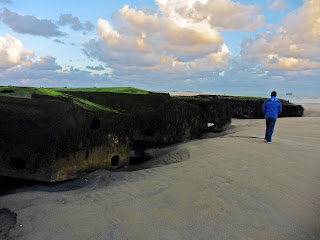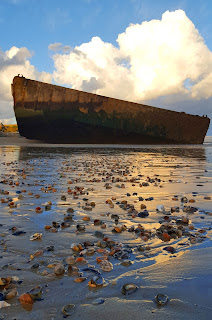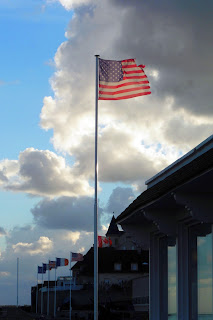Our first stop along the coast was a beach town called Arromanches-les-Bains, near what was code named Gold Beach.
We had some trouble finding our hotel – Hotel de la Marine – because it turned out to be off of a pedestrian only zone which greatly confused our GPS. We ended up dropping my brother off nearby and he went in search of the hotel. Their website says they don’t offer parking, but they actually have a few hidden spots that you have to drive through the pedestrian zone and along the sea wall to get to. We were lucky that it was an off-season, and I wouldn’t count on getting one during the busier summers. The parking area was tiny and pulling in and out of the spaces required quite a few back and forth passes. Getting to drive along the sea wall was kind of neat though, even if it was only for a couple hundred feet.
We were absolutely thrilled with the location of the hotel. It would be the perfect spot for a summer visit with its location right along the sea wall. We almost didn’t find it because we were doing all of our bookings through Expedia and it’s not listed on there. It wasn’t until I tried a search on Booking.com that I located it. I would strongly recommend doing searches on multiple websites to make sure you find everything available because no search engine is comprehensive. We had to have two separate rooms because they could only accommodate two people in each room, but the staff made sure we were right next to each other. We even lucked out with a killer view of the beach.
The hotel had a nice restaurant that we chose for dinner, largely because there didn’t appear to be much else open in town. It seemed expensive, but that was because we hadn’t had any other meals in France yet. (I’m not counting lunch at McDonald’s.) In hindsight, it was pretty much on par with the prices we paid elsewhere in France, and I’ve come to the conclusion that food just costs a fortune there. I ordered a creamy pasta dish that I didn’t particularly care for, but everyone else seemed quite pleased with their food. We split a bottle of wine and toasted to the start of another grand adventure.
The rooms themselves were decent – tiny by American standards, but on par with most places I’ve stayed at in Europe. There was some trouble with the glass around the shower in the room I stayed in that resulted in water leaking all over the bathroom floor, but my brother and sister in the room next door reported no issues with theirs. My only real complaint was the fact that the long curtains covered the radiator so we had to choose between having the room warm, having it dark, or having it both warm and dark until the curtains caught fire. We chose warmth sans fire.
 |
| Cheers! |
The rooms themselves were decent – tiny by American standards, but on par with most places I’ve stayed at in Europe. There was some trouble with the glass around the shower in the room I stayed in that resulted in water leaking all over the bathroom floor, but my brother and sister in the room next door reported no issues with theirs. My only real complaint was the fact that the long curtains covered the radiator so we had to choose between having the room warm, having it dark, or having it both warm and dark until the curtains caught fire. We chose warmth sans fire.
The next morning was when the excitement really kicked in. I got to watch the sky light up over the beach with the remnants of the mulberry harbor while the rest of the family got ready. It was fascinating thinking about the fact that men were storming the beaches at dawn in almost this exact spot on the morning of D-Day. Our room was located directly in front of one of the largest remaining pieces and it was very cool to get to see the breakwaters further out appear along the horizon as day broke.
 |
| Daybreak from our hotel room |
Even though I was in AP History and have read extensively about WWII, I had somehow never heard of the Mulberries until I began planning this trip. Now I’m thoroughly fascinated with the ingenuity that sparked them. The D-Day landing sites were chosen for surprise – the Allies wanted locations that the Germans wouldn’t expect them. Since ports and harbors were the most valuable, the Germans had those heavily fortified with mines and men. The Allied leaders knew that they would have to find a way to supply the troops that landed on the beaches until they could capture one of the harbors on the French coast. In order to do this, they devised the ingenious mulberry harbors – artificial ports that could be used to offload reinforcements and supplies. Giant concrete breakwaters were towed across the English Channel and sunk along with some decommissioned ships to protect the harbor, and floating docks and bridges that were designed to rise and fall with the tide were installed and used to offload thousands of men and supplies for the growing Allied landing force. They were supposed to be built at Omaha and Gold beaches, but a bad storm blew through before they could be finished, and the one at Omaha was so thoroughly destroyed that the Allies abandoned it only the Gold Beach mulberry was used. The idea of “hey, we need a harbor here, so let’s just build one and tow it across the Channel” is mind-blowing to me.
We think these were pieces of one of the floating bridges that were used to offload cargo and people. They’ve been sort of stacked on top of each other like fallen dominoes over the last 72 years. As we wandered around them, some half-buried in sand, I was struck by the idea that visitors another 72 years from now might not even see any traces left behind.
A little further west on the beach was the enormous piece that we had seen from our hotel window. We think this was a piece of one of the floating docks. The sand nearby was dotted with seashells and I am in love with this picture of nature’s beauty contrasted with the hulking remains of a war that destroyed so much. 72 years earlier, artillery shells were exploding over this beach and here we were picking up seashells on a cold, wintery morning.
We strolled back along the sea wall, enjoying the view and posing for pictures. We were pretty cold by that point thanks to the wind and were in need of some hot beverages and a breakfast that ideally involved a lot of pastries.
After grabbing breakfast at a nearby hotel’s restaurant, we checked out and visited the Musee du Debarquement, which is almost entirely devoted to the mulberry harbor here. Looking at dioramas really gave a sense of the scale of the operation. My favorite part was the moving model that showed how the bridges and piers were designed to move up and down with the waves and tide. The museum was fairly small, but very crowded even though it was early morning in the off-season. Several busloads of people arrived close together and swarmed the whole place making it hard to walk through the exhibits.
Around the back of the museum, we found a piece of one of the mulberry bridges that had been moved to replace a damaged bridge over a nearby river for over 50 years. After that bridge was decommissioned in 2004, the span was returned to Arromanches-les-Bains to be displayed.
 |
| By the time we left, the ruins were almost submerged. |
Read more about our trip to France, Belgium, and Luxembourg:





Great Post! I not only enjoyed reading it, but I also learned something new. I was also unaware of the mulberry harbors, and it is always interesting that in desperate times is that human ingenuity really shows.
ReplyDeleteIt's fascinating. I don't know why these harbors are never mentioned in school (at least in the US). Those are the kinds of stories that would get kids hooked on history lessons. The quality of the engineering for such a temporary set-up is also mind-blowing.
DeleteWhat a read! I never new about the mulberry harbors! very refreshing to read more about France and it's history! Thanks
ReplyDeleteGreat post about your adventure in France. I am going tin the Spring and need to budget accordingly since you said that meals are expensive there. Thanks!
ReplyDeleteIt may be different in less touristy areas, but I felt like our meals were pretty expensive, at least in comparison to places in Germany, Austria, and Poland that I've visited the last two years. Drinks especially cost a lot. There was one place in Paris that was charging 7 euros for a Coke, which I just couldn't bring myself to order at that price. Wine and beer were more reasonable, but I'm not much of a drinker so most of the time I'd rather just have a pop with my meal. In better weather, you're more likely to be able to find cheaper street food, I would think, but in 40 degree rain, we weren't really inclined to go hunting for that kind of thing.
DeleteThat's so interesting! Your knowledge of history is really impressive. Good move on catching the ruins earlier before high tide!
ReplyDeleteYes! I can't remember where I read that tip when I was planning, but I would've been so disappointed if we had waited until later because walking around on the beach was definitely the highlight of the day.
DeleteI have been to Normandy last year but in a different place. I remember being in this small village where the church wall had photos of how the place used to be in right after the world war II. It was impressive.
ReplyDeleteSounds like you had a great trip - the hotel seems like a great place to stay. Normandy is a great place to visit and visiting the War Memorials are so moving.
ReplyDeleteYou definitely know your history! Heaps of information in great detail too... I did history high school in Australia (only until year 10) and we barely learnt about what happened to Europe during the Second World War so it's always interesting for me to expand my knowledge even more.
ReplyDeleteI couldn't imagine that 72 years from now, there is a potential for these structures to 'disappear' and visitors then wouldn't be able to see it. Really interesting post!